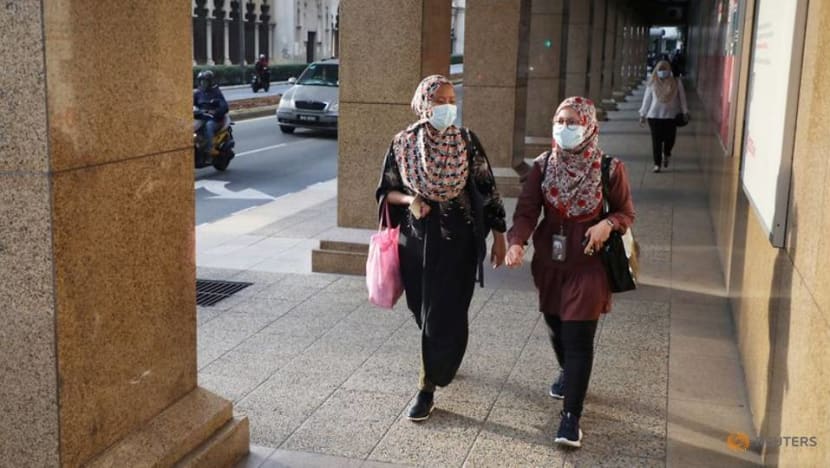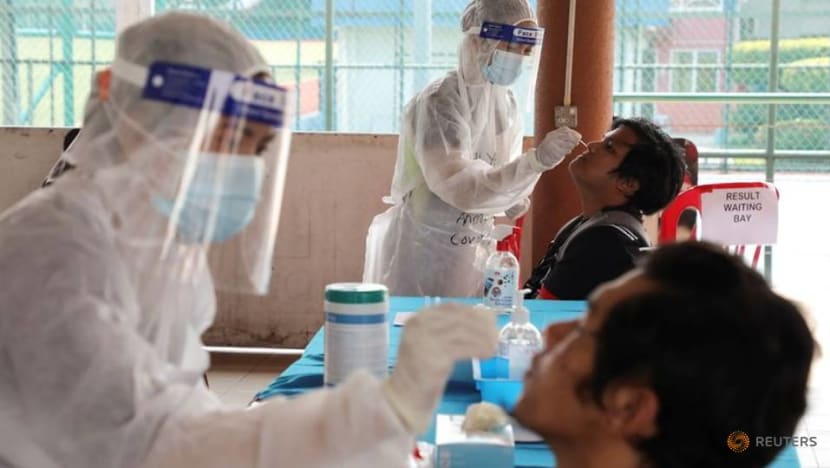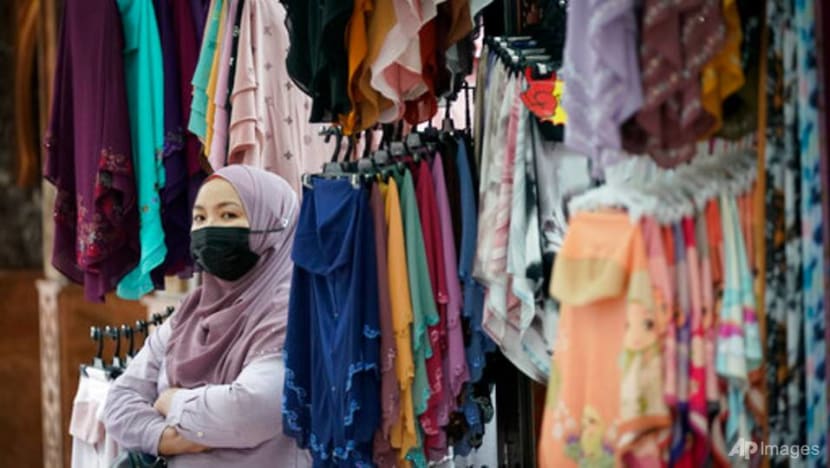commentary Commentary
Commentary: Malaysia’s nationwide MCO - denial, doubts and divisions threaten effectiveness
COVID-19 policy u-turns, knee-jerk reactions and incrementalism in finalising implementation details are fueling public fatigue and a loss of confidence that Malaysia can beat this pandemic, says ISEAS-Yusof Ishak Institute’s Serina Rahman.

People wearing protective masks walk on a street in Kuala Lumpur, Malaysia on Nov 10, 2020. (Photo: REUTERS/Lim Huey Teng)
JOHOR BAHRU: In a surprise move at about 7.30pm on Monday (May 10), Prime Minister Muhyiddin Yassin announced that a Movement Control Order would be imposed on Malaysia effective from Wednesday (May 12).
He posted a series of photographs of a Prime Minister’s Office (PMO) press statement on his Facebook page.
In it were details of activities banned, with festive activities like house and grave visits singled out, along with cross-district and interstate travel, though Aidilfitri prayers are allowed if caps are adhered to.
The news caught everyone off-guard. Coming about an hour after the Malaysian government’s daily COVID-19 press release which gave no inkling of a nationwide MCO, many Malaysians had a rude shock.
The national news agency, Bernama, posted information only an hour after the Facebook post. The Ministry of Defence, placed in charge of national COVID-19 management, only released the list of SOPs at 9.30pm.
The declaration of a nationwide MCO came after many official statements to the contrary. Senior Minister and Minister for Defence Ismail Sabri Yaakob had just reassured the public on Saturday that the government had no plans to impose one.
READ: Commentary: Frustrated with tightened COVID-19 restrictions, Johor residents hope this MCO is the last
YES? NO? WILL THERE BE A NATIONWIDE MCO?
The change is more symbolic and declaratory than in substance and so should in theory be publicly palatable.
With several districts and states already declared MCO areas from May 6, a surprise nationwide ban on inter-district travel anywhere in the country on May 9 was widely perceived to be effectively imposing a national MCO. Hence, the actual declaration of an MCO should not have been unexpected.
Kelantan and two areas in Pahang were already under MCO, with a few areas in Kelantan under Enhanced MCO. Malaysians in other states exhaled a little, thinking they’d been spared.
The intention was to use targeted MCOs in response to rising numbers in specific locations. But the incremental declarations and lack of clarity only served to heighten uncertainty and exasperation.

Mr Ismail Sabri announced that Kuala Lumpur and three districts in Johor would be added to the MCO list barely a week ago. Swiftly after came the addition of Penang Island, a few more areas in Pahang and Perak, and an additional district in Johor.
INCONSISTENCIES, U-TURNS AND CONFUSION
U-turns in the rules compounded public confusion as people struggled to keep track of what the latest changes were.
In this latest MCO, for example, the Ministry of Youth and Sports had earlier announced that individual exercise outside the home would not be allowed, a change from the last MCO. But the ban was retracted two days later after a public outcry.
Take another example: Ramadan bazaars and night markets, initially allowed to proceed for ostensibly economic reasons, subject to local government rules, were ordered to be shut a few days later.
Often, the trouble isn’t just the changing rules, but the short warning businesses, traders and the general public have. Many in F&B and retail have to scramble to clear stock, while households and small businesses have to stockpile to get through the lockdown period.
Mixed messaging from different ministries and ministers adds to the befuddlement.
READ: Commentary: Mixed messaging, misinformation in Malaysia are complicating compliance with COVID-19 rules
When Minister of Science, Technology and Innovation Khairy Jamaluddin, released a list of “potential cluster locations” identified by the national Hotspots Identification for Dynamic Engagement (HIDE) system as an early warning last Thursday, he stressed the move was geared towards enabling better individual decision-making.
Yet, on the same day, Mr Ismail Sabri then announced that these listed premises would be placed under immediate lockdown for three days. This had huge implications for many Malaysians as the list also included public transport hubs.
It often feels like the rules can change at no notice, and businesses and people have to be constantly alert for updates. No announcement can be taken at face value.
For example, while Mr Ismail Sabri said employees needed police permits to travel for work or health purposes as an exception to the ban on inter-district travel, the Ministry of International Trade and Industry Malaysia later clarified that an employment pass and employer’s letter would suffice.

The police also had to highlight that police permits were not necessary for medical appointments and COVID-19 vaccinations.
Most of the anger is directed at the lack of holistic, carefully thought-through measures. Authorities fixate on numbers in each car but not the passengers in densely packed public transportation.
While dining al fresco with safe distancing is not allowed, close-contact, high-density, closed-environment work in factories continue. This despite factory clusters being rife.
NEW LEVELS OF FATIGUE AND FRUSTRATION
All around the world, long lockdowns and changing rules have left people with fatigue and frustration.
This is especially true in Malaysia, when daily-wage earners, small businesses and families have been financially battered with each lockdown.
All this is fueling a sense of hopelessness in escaping the pandemic and the accompanying hardships, with the spotlight turned on government rules.
The policy u-turns are not seen as a willingness on the government’s part to listen to public feedback, but instead are taken as a sign that many restrictions are knee-jerk reactions and guesswork than considered decisions based on science and data.

At the same time, detailed and timely SOPs are lacking and enforcement is selective.
Social media is rife with posts criticising the government and its management of the pandemic. Many cite MCO-induced inconveniences, the negative impacts past MCOs have had on businesses and incomes, and the climbing trend of infection numbers.
DENIAL, DOUBT AND DIVISIONS
The frustration with the government and its lack of clarity and consistency has serious consequences on citizens’ grasp of the dangers of COVID-19 and Malaysia’s recent spike in cases in some areas.
COVID-19 daily infection rates have soared above 4,000 several times in the past two weeks. The number of patients in ICU, intubated and dying are at record highs.
Yet, while some are calling for a return to the tight restrictions of MCO 1.0 to properly stem the rise in infections, not everyone believes that this is the solution.
In the rural outskirts, many yet untouched by the virus struggle to believe that it is dangerous. Most also do not understand how new variants of concern, now circulating in Malaysia, could pose new challenges for the country and necessitate a rapid response when numbers spike.
READ: Commentary: Johor city dwellers hit hard by MCO but rural communities fare worse
Nowhere is this clearer than in Kelantan, which saw a sudden spike in numbers leading to its early MCO. Prior to that, there were many instances of the SOPs being ignored, of people not wearing masks and regular large gatherings. Reports now indicate that the COVID-19 variant originating from South Africa has been found in infection cases there.
Many Malaysians living in the rural outskirts receive news of the desperation in India by Whatsapp, yet struggle to believe that it could happen in their own neighbourhoods.
I have also heard of people denying reported infection numbers and harbouring views that they know of people who were infected but were fine because it is “nothing more than the flu”.
READ: Commentary: Najib Razak’s fine and a tale of double standards in Malaysia
THE REAL DANGER
The danger in Malaysia’s current situation is not the steady rise in infection numbers, but the increasing denial, doubt and divisions brewing on the ground.
The Malaysian government needs a unified communication strategy that focuses on the dangers of the virus, with a sole voice speaking with authority.
The Ministry of Health needs to create and disseminate accessible COVID-19 updates in local languages via Whatsapp and TikTok.

They need to underscore the severity of the situation, of the struggles medical personnel undergo, that COVID-19 and ICU beds are full, and that the number of deaths are steadily increasing.
Because death rituals are so important to rural communities, these videos need to demonstrate how death by COVID-19 entails dying alone and being buried only by medical staff in PPEs. Perhaps this might motivate them to take the virus threat more seriously.
They also need to disseminate information on policy changes and details through similar social media channels.
Complete enforcement is difficult given Malaysia’s size and sprawl. If Malaysia cannot keep such doubts and divisions under control to launch a unified national response, new daily infections breaching 5,000 may come sooner rather than later.
BOOKMARK THIS: Our comprehensive coverage of the COVID-19 pandemic and its developments
Download our app or subscribe to our Telegram channel for the latest updates on the coronavirus outbreak: https://cna.asia/telegram
Dr Serina Rahman, Visiting Fellow at the ISEAS-Yusof Ishak Institute, writes from Johor where she’s in lockdown with the rest of Malaysia.












